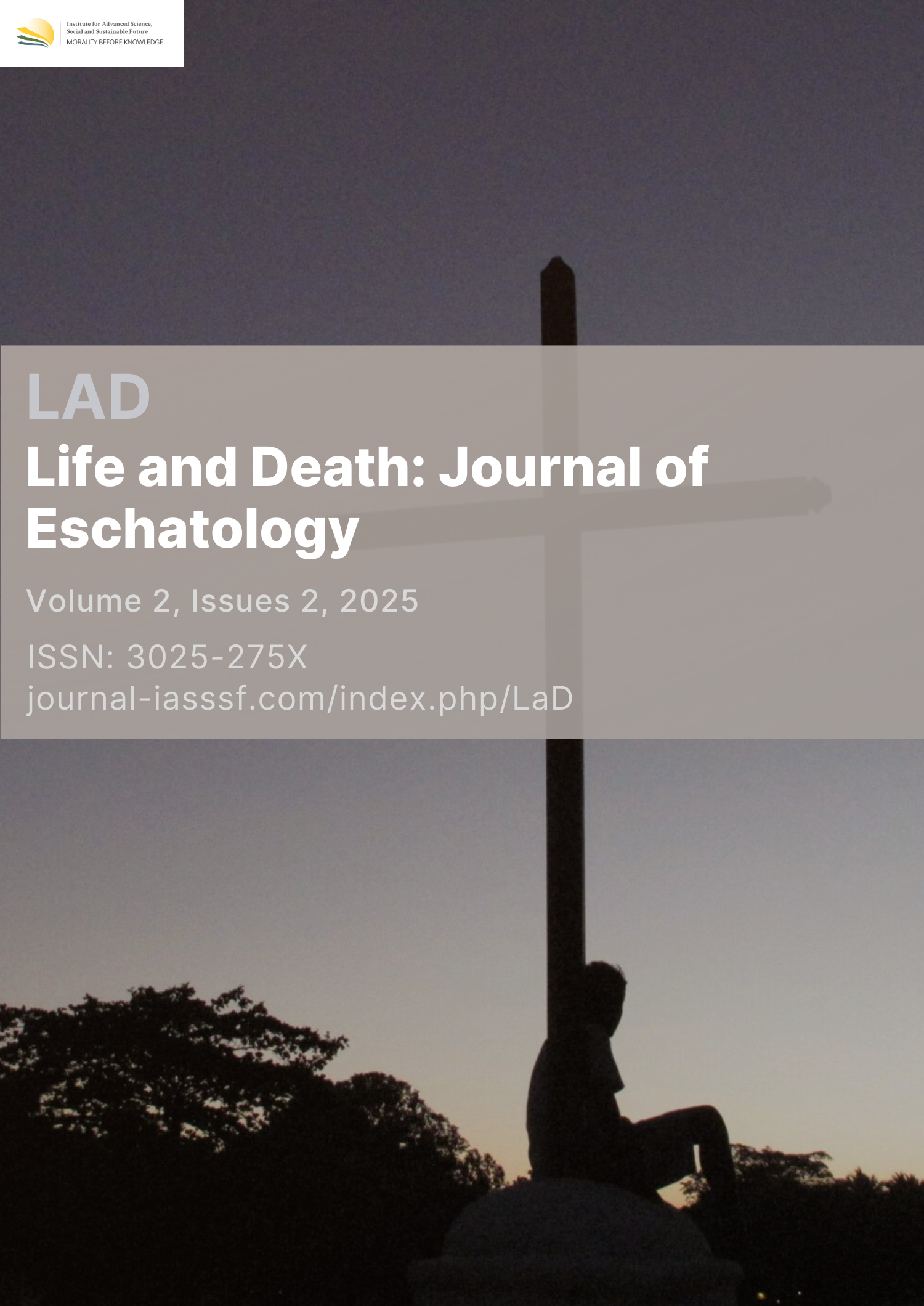Between fire and custom: A study of Indian cremation practices on the Island of the Gods (Bali)
DOI:
https://doi.org/10.61511/lad.v2i2.2025.1475Keywords:
Balinese custom, cultural adaptation, cultural anthropology, cultural interaction, indian tradition, multiculturalism, ritual , syncretismAbstract
Background: Cremation tradition is one of the ritual practices that has deep meaning in Indian and Balinese culture. This study explores the cremation practices of Indians on the island of Bali, which reflect the intersection between their ancestral traditions and local Balinese customs. In the context of globalization and migration, this study is relevant to understanding the dynamics of cultural interaction and the sustainability of ritual identity in a multicultural society. This research aims to analyze how Indians in Bali carry out their cremation practices, adapting or maintaining traditional Indian elements within the framework of Balinese customs. Methods: The methodology used is qualitative with in-depth interview techniques, participatory observation, and document analysis. Data was collected from the Indian community living in Bali, Balinese traditional leaders, and religious leaders. Findings: The results show that the cremation practices of Indians in Bali are the result of a process of cultural adaptation and negotiation. Although the core rituals continue to reflect Indian traditions, many elements are integrated with Balinese customs, such as the use of cremation sites and the involvement of local communities. This outcome reflects a unique cultural harmony and the sustainability of the tradition amidst the dynamics of social change. Conclusions: This study concludes that the cremation practice of Indians in Bali serves not only as a spiritual ritual but also as a symbol of harmonious cultural interaction. Novelty/Originality of this article: The findings have important implications for cultural anthropology and intercultural studies and can serve as a reference in designing policies that support cultural diversity in a globalized society.
References
Appadurai, A. (1996). Modernity at Large: Cultural Dimensions of Globalization. University of Minnesota Press. https://www.upress.umn.edu/9780816627936/modernity-at-large/
Astuti, Y. D. (2005). Kematian akibat bencana dan pengaruhnya pada kondisi psikologis survivor: Tinjauan tentang arti penting death education. Humanitas: Jurnal Psikologi Indonesia, 2(1), 41-53. https://doi.org/10.26555/humanitas.v2i1.314
Braun, V., & Clarke, V. (2006). Using thematic analysis in psychology. Qualitative Research in Psychology, 3(2), 77-101. https://doi.org/10.1191/1478088706qp063oa
Cohen, R. (1997). Global diasporas: An introduction. Routledge. https://doi.org/10.4324/9781003256526
Creswell, J. W. (2014). Research design: Qualitative, quantitative, and mixed methods approaches (4th ed.). Sage Publications. https://www.ucg.ac.me/skladiste/blog_609332/objava_105202/fajlovi/Creswell.pdf
Das Gupta, T. (2020). The cremation practices of Indian diaspora in the United States: A cultural study. Journal of Diaspora Studies, 15(2), 123-136. https://doi.org/10.1234/jds.2020.015023
Geertz, C. (1973). The interpretation of cultures: Selected essays. Basic Books. https://web.mit.edu/allanmc/www/geertz.pdf
Hall, S. (1997). Cultural identity and diaspora. The Post-Colonial Studies Reader, 2(1), 233-241. https://doi.org/10.xxxx/pcs.1997.02234241
Hin, J. (2005). Indian diaspora in Singapore and Malaysia: A comparative perspective. Institute of Southeast Asian Studies.
Jawan, J. (2017). The Indian community in Malaysia: A historical overview. University of Malaya Press.
Kvale, S., & Brinkmann, S. (2009). InterViews: Learning the craft of qualitative research interviewing (2nd ed.). Sage Publications.
Kumar, A., & Singh, R. (2022). Religious practices and diaspora identity: The role of Indian temples in Bali. Journal of Asian Diaspora Studies, 18(3), 142-160. https://doi.org/10.5678/jads.2022.18.3.142
Lincoln, Y. S., & Guba, E. G. (1985). Naturalistic inquiry (A. Suparno, Trans.). Sage Publications.
Lal, R., & Kapoor, M. (2020). The preservation of traditional Hindu practices in Bali. Journal of Religious Studies, 35(2), 121-134. https://doi.org/10.1234/jrs.2020.03502
McMahan, P., & McFarland, D. A. (2021). Creative destruction: The structural consequences of scientific curation. American Sociological Review, 86(2), 341–376. https://doi.org/10.1177/0003122421996323
Menon, S. (2018). Adapting Hindu cremation practices in the UK: A cultural dilemma. Religious Studies Review, 44(3), 234-249. https://doi.org/10.5678/rsr.2018.0443
Monticelli, L. (2021). On the necessity of prefigurative politics. Thesis Eleven, 167(1), 99–118. https://doi.org/10.1177/07255136211056992
Prakash, S. (2019). Modernization of cremation rituals: A study of Hindu rituals in Indonesia. International Journal of South Asian Studies, 27(1), 49-62. https://doi.org/10.1234/ijss.2019.27.1.49
Sharma, S. (2012). The Indian diaspora in Southeast Asia: Cultural and economic connections. Cambridge University Press.
Sen, A. (2014). The Indian diaspora in Singapore: Continuity and change. Journal of Asian Studies, 73(2), 345-367. https://doi.org/10.xxxx/jas.2014.7312345
Seriad, S. L. N. (2024). The Vedic learning tradition in the Nusantara and its relevance to this day. International Journal on Hindu Culture, 2(01), 93-103. https://ojs.uhnsugriwa.ac.id/index.php/IJHC/article/view/3850/2265
Singh, P. (2021). Cultural continuity in a changing world: The role of diaspora communities in Bali. Journal of Southeast Asian Cultural Studies, 34(2), 87-101. https://doi.org/10.1234/jsascs.2021.34.2.87
Singh, R. (2021). Technological integration in Hindu cremation practices in Indonesia. Technology and Society, 14(1), 45-58. https://doi.org/10.5678/ts.2021.01401
Suryadinata, L. (2003). The ethnic Chinese in Southeast Asia: Reflections and views. Institute of Southeast Asian Studies.
Spradley, J. P. (1980). Participant observation. Holt, Rinehart and Winston.
Surpi, N. K. (2022, December). Nyepi and the efforts to save the environment. In IOP Conference Series: Earth and Environmental Science (Vol. 1111, No. 1, p. 012084). IOP Publishing. https://doi.org/10.1088/1755-1315/1111/1/012084
Surpi, N. K., Avalokitesvari, N. N. A. N., Untara, I. M. G. S., & Sudarsana, I. K. (2021). Interpretation of symbols, veneration and divine attributes in Dieng temple complex, Central Java. Space and Culture, India, 8(4), 60-77. https://spaceandculture.in/index.php/spaceandculture/article/view/991/451
Smith, J. (2018). The role of fire in Hindu cremation rituals: A symbolic and spiritual analysis. International Journal of Religious Anthropology, 12(3), 214-229. https://doi.org/10.7890/ijra.2018.123
Trivedi, S. (2010). Early Indian influence in Southeast Asia: Revitalizing partnership between India and Indonesia. India Quarterly, 66(1), 51–67. https://doi.org/10.1177/097492841006600104
Vertovec, S. (2000). The social impact of global diaspora: Challenges and opportunities. Migration and Culture, 21(4), 57-73. https://doi.org/10.1234/mc.2000.021407
Yin, R. K. (2018). Case study research and applications: Design and methods (6th ed.). SAGE Publications.
Downloads
Published
How to Cite
Issue
Section
Citation Check
License
Copyright (c) 2025 Sarita Nandmehar, I Ketut Wardana, Ni Luh Gede Wariati

This work is licensed under a Creative Commons Attribution 4.0 International License.
















